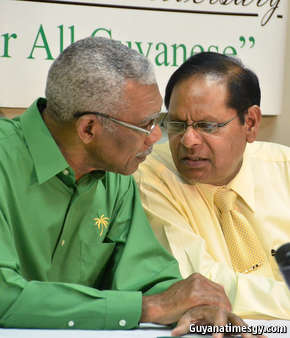A time to heal
The new government could narrow the racial divide
May 23rd 2015, Source
IN THE half century since Guyana won independence from Britain, it has switched governing parties only twice. The second time was on May 16th, when David Granger, a former chief of the country’s tiny army, was sworn in as president. His election ends 23 years of rule by the People’s Progressive Party (PPP), which is dominated by Guyanese of Indian origin, whose forebears came over as indentured workers. Mr Granger belongs to the country’s other big ethnic group, descendants of slaves from Africa.
Whether this month’s election will do anything to lessen the racial polarisation that defines Guyana’s politics is unclear. The most hopeful sign is that Mr Granger ran at the head of a two-party coalition that includes the Alliance for Change (AFC), a multiracial party. It named the prime minister and also has other cabinet posts. Mr Granger’s party, A Partnership for National Unity, is also promising less divisive politics. That offers a glimmer of hope.
The conduct of the election itself does not. It was triggered by a stand-off between the outgoing president, Donald Ramotar, and parliament, which was controlled by his opponents. Each side blocked legislation proposed by the other. To avoid a no-confidence vote, Mr Ramotar prorogued parliament in November and called early elections in February.
It was a close race, which sharpened its tone. In the Indo-Guyanese village of Enterprise, PPP supporters spray-painted two donkeys in opposition colours, then beat them nearly to death. The PPP reminded voters that when the forerunner to Mr Granger’s party last held power, through rigged elections, from 1964 to 1992, basic goods such as cheese and wheat flour were almost unobtainable. Race riots in the 1960s left scores of people dead and forced thousands from their homes.
Under the PPP the economy improved but it did not have much else to boast about. The trans-shipment of cocaine flourishes alongside gold mining. After a generation in power the PPP acquired a reputation for mismanagement and cronyism. Among its parliamentary candidates were one of the president’s sons and six children of present or former ministers.
Participation among fired-up voters was 20% higher than in the last election in 2011. The PPP slightly increased its share of the vote (and continues to insist that it won). In fact, Mr Granger’s coalition won narrowly because it fought the election on a single electoral list. In 2011 its two parties ran separately, gaining a majority in parliament, which is elected by proportional representation, but losing the presidency to Mr Ramotar, because his party was the largest single vote-getter. The emigration of Indo-Guyanese also helped Mr Granger’s coalition win this time.
The 69-year-old former brigadier promises useful changes including, fortuitously, a sovereign wealth fund. On May 20th Exxon Mobil announced Guyana’s first significant oil find. The best chance of overcoming Guyana’s racial divide may be Mr Granger’s partnership with the new prime minister, Moses Nagamootoo, an Indo-Guyanese from the wonderfully named village of Whim in the east. He was a senior figure in Mr Ramotar’s party (and had been seen as a potential president) but left to join the multi-racial AFC in 2011. Under the new government, the prime minister will have expanded powers: he will chair cabinet meetings and appoint heads of state agencies.
The role set out for Mr Nagamootoo and other Indo-Guyanese in the cabinet looks like something more than the tokenism that past governments have practised. That is a good sign. If the new coalition can get Guyana thinking about issues besides race, it can make progress.

The brigadier and the man from Whim
